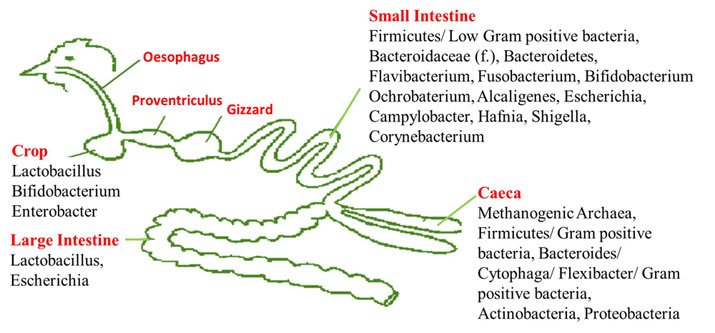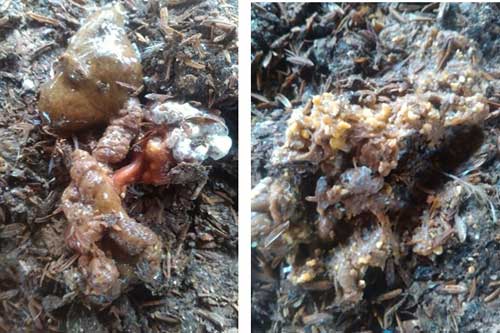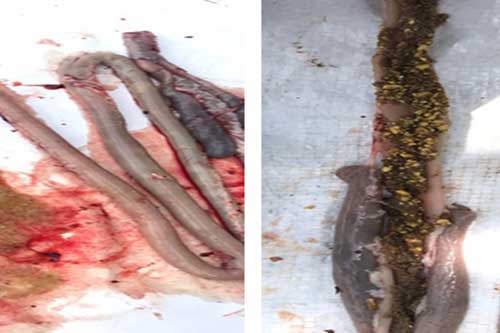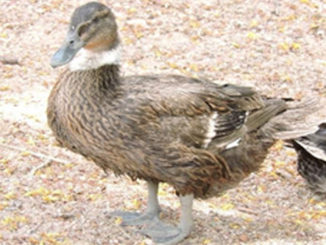Introduction
The efficient conversion of feed into its necessary components for adequate absorption of nutrients is vital, both for the production and welfare of broiler as well as broiler breeder. Digestion and nutrient absorption are affected when gut health is compromised. Which, in turn, can harm nutrient digestibility, resulting in economic loss and increased disease susceptibility. Broilers are presently reared to achieve a high growth rate and feed efficiency. Initially, chicks are selected for fast-growing, generally lean and breast meat for food production. Genetic improvements and other strategies have been made to achieve high levels of FCR and growth rate. They are often directly related to digestive problems, including the passage of partially digested feed (or feed passage syndrome) with impeded intestinal function. This could be due to the limited access to necessary nutritional raw materials and poor management practises. Broilers are mostly affected by feed passage syndrome seen in commercial farms from decades in our country. “Passage of digested or undigested feed in broiler faeces continued to be recorded sporadically in broiler integrations”. Passage of nutrients into the faeces is due to insufficient digestion and intestinal absorption. This passage of undigested feed into faeces has significantly impacted weight gain, FCR, skin colour and flock uniformity which will ultimately lead to a severe loss of productivity. The digestive tract seems to have the most extensive exposed surface in the body. A broad range of diet-related factors and infectious disease agents can adversely affect the delicate balance of micro biota in the chicken digestive tract. Disorders in this balance can affect birds’ overall health and performance in the production of commercial poultry farms. This article aims to explore the area of digestive health problems and outline key factors that are involved in causing feed passage syndrome in broilers.
Factors affecting feed passage syndrome
FPS (Feed passage syndrome) is a multifaceted problem, a wide range of diet-related factors, infectious disease agents, climate and management practises can adversely affect the delicate balance of chicken gut components and consequently affect the growth rate and feed utilization efficiency. For example, time of nutrient interaction with digestive enzymes, absorbent surfaces and microbial communities.
1. Dietary Factors
- The time of nutrient exchange with digestive enzymes, absorbent surfaces and microbial.
- Ingredients like wheat, barley, rye or cassava in the diet cause excess wet droppings because of the high content of non-starch polysaccharides (NSP) and digesta containing high levels of NSP allows an ideal environment for pathogenic bacteria like Clostridium perfringens.
- Oxidized oil, mycotoxin, tannin, gizzerosine, biogenic amine and salt in the diet will also influence digestive problems.
2. Balance of the microbiota in the gut
- Dysbacteriosis or dysbiosis is characterized as a disease-associated “imbalance” in the gut microbial population. The increase or loss of group members or changes in relative microbial abundance is responsible for this syndrome.

Spatial distribution of most common and abundant bacterial taxa in GIT of chicken - Secondary bacterial infections, necrotic enteritis, viral infections, clinical and sub-clinical coccidiosis, ascarids and cestodes etc. are responsible for this imbalance in gut microbial population.
- These secondary infections will cause damage to intestinal lining, gut irritation and lead to imperfect feed passage. There is also overgrowth of harmful bacteria like Clostridium perfringens.
3. Quality of feed and drinking water
- Low quality of feed materials with anti-nutritional factors like gizzerozine, biogenic amines, tannins, trypsin inhibitors and rancid fat will affect digestibility of feed.
- Lower grain quality is the primary source of mycotoxins with mould growth – ochratoxins, aflatoxins alter intestinal fragility and affect intestinal absorption.
- Feed grinding process may cause gizzardous erotions, intestinal epithelial sloughing, enteritis, etc.
- Poor quality of water with a high content of TDS, minerals and pH causes a higher intestinal irritation and poor absorption of nutrients, resulting in a rapid passage of the feed-in intestine.
4. Faulty management practices
- Improper biosecurity environment which will lead to the development of infections with viruses, bacteria or coccidiosis, ascarids and cestodes. They are affecting growth and FCR in birds.
- Environmental stress conditions – during heat stress, there is oxidative stress and lesser feed intake, low digestibility and passage of undigested feed.
- Decreased litter quality will lead to many of parasitic infections of intestinal tract like coccidiosis, that affecting bird’s growth and development.
Signs of feed passage syndrome
The movement of undigested feed or wet droppings is the characteristic findings of a wide variety of possible signs in feed passage syndrome. During winter and early spring, the disorder can be more severe and is the major challenge for poultry farmers and veterinarians. Investigating the causes includes a thorough inspection of the infected poultry, analysis of the existence of intestinal parasites, bacterial culture, and isolation of viruses, histopathology and toxicological testing.
- The first clinical signs can be seen mostly at three days of age, but most often in chicks aged 6 to 12 days and can last until 3 – 6 weeks.
- The chicks are always pale, dirty and muddy, and may have abdominal distension.
- Presence of large particles of corn, excess moisture, typical green colour with orange mucus and soft faeces formation.
- Affected birds show poor shank pigmentation, reduced weight changes, reduced feed conversion, low plumage, proventriculus enlargement, low body weight, variable uniformity of the flock and a decreased gizzard size.
- Lesions are mostly seen in the proventricular, gizzard and small stomach.
- There is an increasing number of small and undersized birds, mostly marked by cloacal pasting and faecal stripes.
- Muddy undigested food passage is visible in the litter, and there are muddy soil and heavy caking due to diarrhoea, watery droppings and excess flush

Droppings containing undigested feed visible to the naked eyes - Dropping loses its shape, and the typical white uric acid cover over faces and sometimes droppings have a yellow/orange shade with undigested feed visible to naked eyes. They are watery sometimes.

Droppings with typical white uric acid and yellow orange cover over faces - The intestinal wall is small, precise and delicate. There are bowel swelling and inflammation. In the intestine, green mucus and undigested feed are found.

Necropsy findings in feed passage syndrome (Bowel swelling and undigested particles in the colon inflammation)
Preventive measures
Play a crucial role in maintaining gut health and reducing the assimilation of pathogenic digestive tract microorganisms of birds, which includes mainly management practices that are followed in poultry farms.
- The following of recommended management practises from the day of arrival of chicks at poultry farms could help to avoid the sensitivity of the chicks to enteric field virus infections and minimize the environmental agents that are engaged in the induction of this condition. Use of proper decontamination/biosecurity measures.
- An adequate number of feeding and watering equipment should be provided to the chicks.
- By focusing on the consistency of food, protein and fat content, the content of feed ingredients can be improved. Modification of diets and additions of exogenous enzymes to diets that contain wheat, barley, oat, or rye will significantly lower the levels of NSP and reduce the risk of necrotic enteritis in groups that are fed with these cereals.
- The frequent use of functional additives to resolve bacterial pathogens and to avoid intestinal health problems which facilitate to the regeneration of intestinal epithelia and allows tissue growth and repair.
- Use of probiotics, prebiotics application to promote gastrointestinal health and microbiota balance.
- Measures need to be taken to track the efficacy of the management programme. The new anticoccidial plan should be re-assessed to improve the management of disease useof mould inhibitors and binding agents to prevent infections.
- The litter consistency, sanitation in farms and feeding areas, temperatures and house humidity should be streamlined regularly. The litter must be of acceptable quality and free of foreign materials.
Conclusion
Feed passage syndrome directly affects broiler economic production, such as feed conversion efficiency and body weight. Essential aspects of ensuring the best bird performance and health are by maintaining the balance of good intestinal health. Management types, the environment, pathogens and feedstuffs all affect the health of the intestines. Good bird management practises essential to protect the birds’ health, wellbeing and efficiency. Enhanced gut health, which explains improved growth and FCR, contributes to better digestion and absorption of nutrients. So it is essential to maintain intestinal health by basic management practises which play a crucial role in preventing this feed passage syndrome.







Be the first to comment